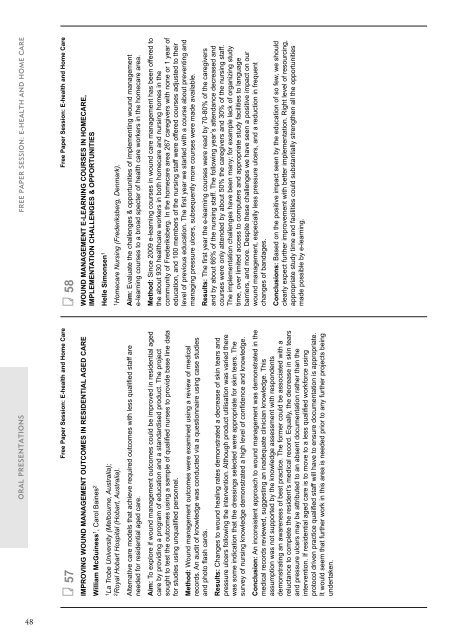You also want an ePaper? Increase the reach of your titles
YUMPU automatically turns print PDFs into web optimized ePapers that Google loves.
ORAL PRESENTATIONS<br />
57<br />
Free Paper Session: E-health and Home Care<br />
Improving wound management outcomes in residential aged care<br />
William McGuiness 1 , Carol Baines 2<br />
1 La Trobe University (Melbourne, Australia);<br />
2 Royal Hobart Hospital (Hobart, Australia).<br />
Alternative care models that achieve required outcomes with less qualified staff are<br />
needed for residential aged care.<br />
Aim: To explore if wound management outcomes could be improved in residential aged<br />
care by providing a program of education and a standardised product. The project<br />
sought to test the outcomes using a sample of qualified nurses to provide base line data<br />
for studies using unqualified personnel.<br />
Method: Wound management outcomes were examined using a review of medical<br />
records. An audit of knowledge was conducted via a questionnaire using case studies<br />
and photo flash cards.<br />
Results: Changes to wound healing rates demonstrated a decrease of skin tears and<br />
pressure ulcers following the intervention. Although product utilisation was varied there<br />
was some indication that the dressings selected were appropriate for skin tears. The<br />
survey of nursing knowledge demonstrated a high level of confidence and knowledge.<br />
Conclusion: An inconsistent approach to wound management was demonstrated in the<br />
medical records reviewed, suggesting an inadequate clinician knowledge. This<br />
assumption was not supported by the knowledge assessment with respondents<br />
demonstrating an awareness of best practice. The former could be associated with a<br />
reluctance to complete the resident’s medical record. Equally, the decrease in skin tears<br />
and pressure ulcers may be attributed to an absent documentation rather than the<br />
intervention. If residential aged care is to move to a less qualified workforce using<br />
protocol driven practice qualified staff will have to ensure documentation is appropriate.<br />
It would seem that further work in this area is needed prior to any further projects being<br />
undertaken.<br />
FREE PAPER SESSION: E-HEALTH AND HOME CARE<br />
58<br />
Free Paper Session: E-health and Home Care<br />
WOUND MANAGEMENT E-LEARNING COURSES IN HOMECARE,<br />
IMPLEMENTATION CHALLENGES & OPPORTUNITIES<br />
Helle Simonsen 1<br />
1 Homecare Nursing (Frederiksberg, Denmark).<br />
Aim: Evaluate the challenges & opportunities of implementing wound management<br />
e-learning courses to a broad specter of health care workers in the homecare area.<br />
Method: Since 2009 e-learning courses in wound care management has been offered to<br />
the about 930 healthcare workers in both homecare and nursing homes in the<br />
community of Frederiksberg. In the homecare area 267 caregivers with none or 1 year of<br />
education, and 100 members of the nursing staff were offered courses adjusted to their<br />
level of previous education. The first year we started with a course about preventing and<br />
managing pressure ulcers, subsequently more courses were made available.<br />
Results: The first year the e-learning courses were read by 70-80% of the caregivers<br />
and by about 66% of the nursing staff. The following year’s attendance decreased and<br />
courses were only attended by about 50% the caregivers and 30% of the nursing staff.<br />
The implementation challenges have been many; for example lack of organizing study<br />
time, over limited access to computers and appropriate study facilities to language<br />
barriers, and more. Despite these challenges we have seen a positive impact on our<br />
wound management, especially less pressure ulcers, and a reduction in frequent<br />
changes of bandages.<br />
Conclusions: Based on the positive impact seen by the education of so few, we should<br />
clearly expect further improvement with better implementation. Right level of resourcing,<br />
appropriate study time and facilities could substantially strengthen all the opportunities<br />
made possible by e-learning.<br />
48






